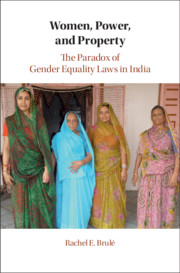Book contents
- Frontmatter
- Dedication
- Contents
- List of Figures
- List of Tables
- Acknowledgements
- 1 Introduction
- 2 A Theory of Political Representation and Economic Agency
- 3 Property and Power: A Political History of the Hindu Joint Family
- 4 Where Are the Women? Investigating Reform’s Roots
- 5 The Politics of Property Rights Enforcement
- 6 The Long Arm of Resistance: Refusal to Care for Parents
- 7 Representation and Violence: Gender Equality and Sex Selection
- 8 Conclusion
- 9 Data Appendix
- Bibliography
- Index
3 - Property and Power: A Political History of the Hindu Joint Family
Published online by Cambridge University Press: 16 October 2020
- Frontmatter
- Dedication
- Contents
- List of Figures
- List of Tables
- Acknowledgements
- 1 Introduction
- 2 A Theory of Political Representation and Economic Agency
- 3 Property and Power: A Political History of the Hindu Joint Family
- 4 Where Are the Women? Investigating Reform’s Roots
- 5 The Politics of Property Rights Enforcement
- 6 The Long Arm of Resistance: Refusal to Care for Parents
- 7 Representation and Violence: Gender Equality and Sex Selection
- 8 Conclusion
- 9 Data Appendix
- Bibliography
- Index
Summary
Property and social privilege are two of the most enduring forms of authority, and families often jealously guard the control and transfer of these sources of influence. This chapter explains the social conventions around the Hindu extended family (encompassing control of property, social alliances, and the politics of mobility and public voice) that govern the intrahousehold distribution of power. After exploring how they have been constructed, I study the unintended consequences of multiple attempts during British colonial rule to legislate gender-equalizing social reforms. The British attempted to homogenize diverse religious, spiritual, and pragmatic traditions into a single code with a tiny elite of highly educated Brahman men at the top. Comfortably, the elite’s sense of “tradition” looked much like the male British colonial ideal of “classical patriarchy” in terms of control of property and social authority. Ironically, this British-Brahman imposition has become integral to India’s legal code. The chapter next details the changes to the ecosystem of norms around women’s traditional property rights, and their enforcement, from independence to contemporary India. Where relevant, I include insights from my field research about the continuity of familial expectations around what it means to be a “good” Hindu son or daughter.
- Type
- Chapter
- Information
- Women, Power, and PropertyThe Paradox of Gender Equality Laws in India, pp. 57 - 69Publisher: Cambridge University PressPrint publication year: 2020

